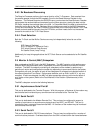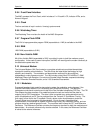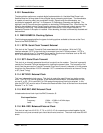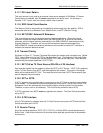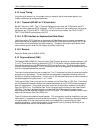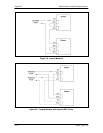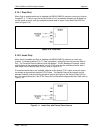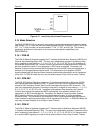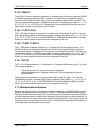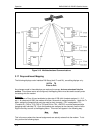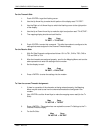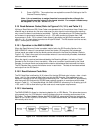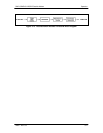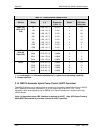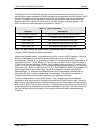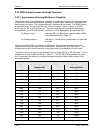
DMD15/DMD15L IBS/IDR Satellite Modem Operation
TM051 - Rev. 5.8 3-17
3.16.4 PCM-31C
The PCM-31C Mode of Operation supports an E1 Interface with no Multiframe Alignment (MFAS)
or Channel Associated Signaling (CAS). In addition, the Drop Function verifies the received
terrestrial CRC checksum and the Insert Function calculates the required CRC checksum. The
user may independently program ‘n’ timeslots to drop and ‘n’ timeslots to insert where ‘n’ = 1, 2, 3,
4, 5, 6, 8, 10, 12, 15, 16, 20, 24, or 30. Because there is no implied ABCD signaling, the user is
free to select timeslot 16 as a Drop or Insert Timeslot.
3.16.5 T1-D4/T1-D4-S
The T1-D4 Mode of Operation supports a T1 Interface with 12 frames per multiframe. The user
may independently program n timeslots to drop and n timeslots to insert where n = 1, 2, 3, 4, 5, 6,
8, 10, 12, 15, 16, 20, 24, or 30. In the DMD15/DMD15L, Robbed Bit Signaling (RBS) is handled
without any need for operator intervention and is transparent to the user.
3.16.6 T1-ESF/ T1-ESF-S
The T1-ESF Mode of Operation supports a T1 Interface with 24 frames per multiframe. The
CRC-6 checksum is automatically checked by the Drop Function and generated by the Insert
Function and placed in the appropriate F-bit positions in the terrestrial multiframe. The user may
independently program n timeslots to drop, and n timeslots to insert, where n = 1, 2, 3, 4, 5, 6, 8,
10, 12, 15, 16, 20, 24, or 30. In the DMD15/DMD15L, Robbed Bit Signaling (RBS) is handled
without any need for operator intervention and is transparent to the user.
3.16.7 SLC-96
The T1 SLC-96 Mode supports a T1 Interface with 12 Frames per Multiframe (as per T1-D4) with
the following exceptions:
The signaling frames (F
s
bits) are sent twice in succession.
During the subsequent four signaling frames, the F
s
bits are replaced with data link
information bits.
The data frame is composed of six signaling frames with a length of 9 msec. The user may
independently program n timeslots to drop, and n timeslots to insert, where n = 1, 2, 3, 4, 5, 6, 8,
10, 12, 15, 16, 20, 24, or 30. In the DMD15/DMD15L, Robbed Bit Signaling (RBS) is handled
without any need for operator intervention and is transparent to the user.
3.17 Multidestinational Systems
Because the Drop and Insert Functions are completely independent, the DMD15/DMD15L easily
supports multidestinational communications. Figure 3-13 illustrates a Multidestinational System
with one Hub site and three remote sites. At the Hub site, thirty channels are being transmitted to
all three remote sites and a fractional set of channels is being received from each remote site. At
the other end of the link, each remote site is transmitting a fractional E1 to the Hub site as well as
receiving all thirty (30) channels from the Hub site. It also identifies those channels intended for it,
and inserts them into the terrestrial data stream.



